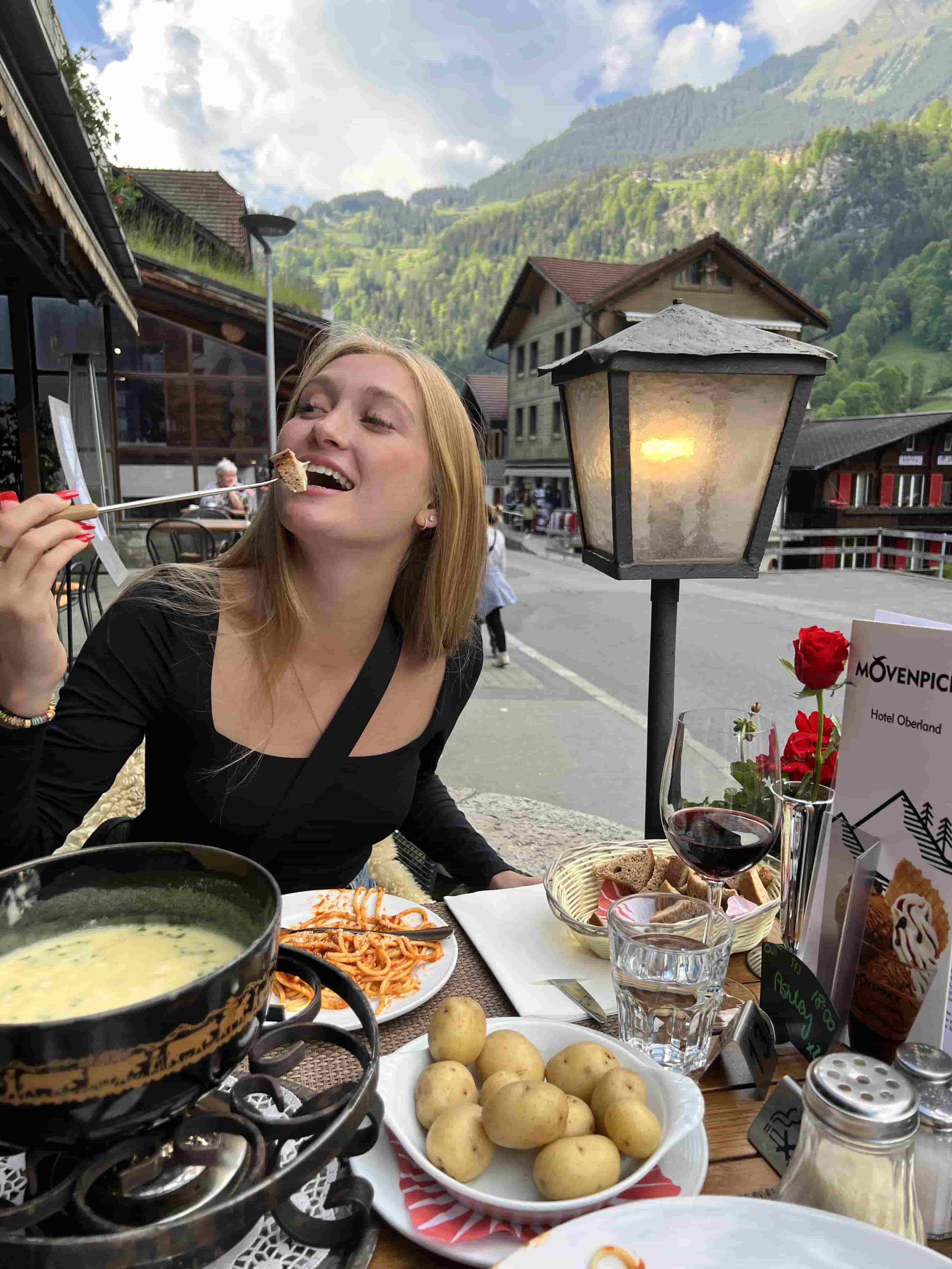3 Days in Santorini, Greece: Volcanic Sand & Caldera Sunsets
LAST UPDATED: | TRAVEL DATE: | EST. READING TIME: 25 MIN
IN THIS GUIDE ✺
The crown jewel of the Cyclades, this 3-day Santorini itinerary unfurls where world-class sunsets dip beneath the dark caldera rim. Revel in the romance of luxury cliffside escapes as a coveted bucket list stay.
The most coveted Cycladic island topping every first-timer’s itinerary, dreamy Santorini is a bucket list destination for honeymooners and intrepid travelers alike. Whitewashed villages perch precariously on the volcanic rim of a staggeringly tall caldera, epitomizing a quintessential image of Greece recognized worldwide.
While global notoriety draws crowds in hordes and skyrockets prices above fair market value, there’s a reason visitors return to Santorini year after year. Unmistakable magic is found in the quiet corners, whether that’s the daybed of a black sand beach club or a catamaran net on a sunset cruise. Embrace the finer things in life from world-class sunsets and acclaimed Greek grapes to 5-star cave hotels and regularly awarded restaurants—when in Santorini, this is the type of place that deserves a splurge. With limited time to spare, discover what to see in Santorini in 3 days to indulge in the luxury trip of a lifetime.
3 Days in Santorini Itinerary
In a hurry? Here’s a time-stamped overview of the detailed how to spend 3 days in Santorini itinerary you’ll find below:
Day 1
Oia in an Afternoon
3:00 - 5:00 PM: 🏰 Wander through Oia after settling in, exploring the Blue Domes, Windmills, and Castle of Oia (2 hr)
5:00 - 6:30 PM: 🏊♀️ Cool off with a late afternoon dip in the public Lioyerma Pool Bar (1 hr 30 min)
8:00 - 9:30 PM: 🌅 Take in your first Santorini sunset during dinner at The Athenian House in Imerovigli (1 hr 30 min)
Day 2
From Caldera Hikes to Plate-Smashing Nights
8:00 - 8:45 AM: 🥞 Fuel up with a farm-to-table Greek breakfast inside Karma’s garden oasis (45 min)
9:00 AM - 12:00 PM: 🥾 Hike from Oia to Fira, adding on the Skaros Rock detour in Imerovigli (3 hr)
12:00 - 1:00 PM: 🌊 Look out over the caldera during lunch at Volkan on the Rocks (1 hr)
1:00 - 1:20 PM: 📚 Pop into polyglot Atlantis Books across the street to snag a literary souvenir (20 min)
1:45 - 4:30 PM: 🍹 Bask on black volcanic sand at the Veuve-branded Seaside Santorini beach club (2 hr 45 min)
7:30 - 9:00 PM: 🦑 Head back to Fira during dinner at Esperisma for more fine dining with a sunset view (1 hr 30 min)
9:30 - 11:30 PM: 🍽️ Dance kalamatiano, toast “Yamas!,” and smash plates at The Greek Wedding Show (2 hr)
Day 3
Cliff Jumping & Catamaran Cruising
11:45 AM - 1:00 PM: 🐟 Take the Oia steps down to Ammoudi Bay for a swanky lunch at bumping Basalt (1 hr 15 min)
1:00 - 2:00 PM: 🏊♀️ Scramble around the craggy corner to cliff jump off Saint Nicholas island (1 hr)
2:30 - 9:30 PM: 🛥️ Cruise around the caldera on a luxury catamaran to the black, white, and red sand beaches (7 hr)
Click the star next to the title of this interactive map featuring all the stops detailed in the 3-day Santorini itinerary above to add it to your Google account for easy navigation during your trip!
Where is Santorini?
Arguably the most famous Greek island, Santorini is one of the southernmost destinations in the Cyclades—20 kilometers to the east, Anafi claims the title as the furthest member of the archipelago. With around 20,000 permanent residents, this volcanic crater neighbors Ios to the north and Crete much further south. Further from Athens than other Aegean stops, this increased commute hasn’t deterred tourism to the coveted honeymoon retreat by any means, with cruise ships dropping the population of a small city off daily during the peak summer season. It’s unlikely you’ll find a more crowded cobblestone alleyway on any other island, since this is the dream destination added to practically every first-timer’s Greece itinerary.
A caldera, or collapsed cauldron remaining after a volcanic eruption, the main island of Santorini is shaped like a half moon crescent. A thousand feet above sea level, the staggering, black basalt cliffside rises abruptly from the ocean below, with western tip towns like Oia built directly into the narrow rim. Winding around this rugged ridge poses a transportation challenge, as only a handful of main roads link the villages—turning even short trips into time-consuming journeys. While seasonal Meltemi winds are less intense on southern Santorini, moderating the island’s heat and humidity, gusts feel stronger on exposed edges while hiking between Oia and Fira or on open beaches like Perissa’s black shores.
How to Get to Santorini From Athens?
FLY: Santorini is served by a small airport with direct, 55 minute flights into JTR from Athens (ATH). Located significantly south in the context of the Cyclades as a whole, flying is undoubtedly the quickest way to reach the island. From there, use the robust ferry system to hop from one Aegean destination to the next.
The recently renovated airport is a single, low-lying terminal accustomed to processing millions of passengers each year, with the majority of travelers concentrated within the high summer season. Located towards the eastern edge halfway down the island, a taxi or transfer is required for point-to-point transportation to your accommodations. Otherwise, KTEL buses run from the airport to Fira.
FERRY: Taking the ferry from Piraeus in Athens to Santorini is an altogether more time-consuming pursuit, with the quickest SeaJets lines running a 5 hour route while the slowest Fast Ferries option takes 9 hours and 55 minutes. Find connections from any other Cycladic stops on FerryHopper, which offers live schedule updates and ferry tracking. All ferries dock in the Thira port, which is conveniently located on the western edge of the caldera just south of the central transport hub, Fira.
As with all ferry travel, time is saved upon arrival since there’s no formal check-in or security process like those required at airports—simply walk up to the port, locate which corridor corresponds to your vessel, and board alongside other guests once the back door comes down. Check in and prepare your QR code to present to the conductor before boarding, then place your luggage in the cargo hold alongside parked vehicles or in the passenger lounge—carry-ons and personal items can fit in either. Locate your seat with odd and even numbers typically split into separate sides; staff members can guide you to the correct chair. Enjoy amenities which typically include outlets, tray tables, and a full-service café before heading back down to the cargo hold once your intended destination is announced over the speakers.
How to Get Around Santorini?
WALK: Unlike compact cities, it’d be a fool’s errand to attempt to walk around any of the Cycladic islands. The highlights are far too dispersed to justify traveling all that way just to remain in the town closest to the ferry port. That said, many whitewashed settlements are built around narrow lanes that cars can’t access. Oia is one such village on Santorini that’s best traversed on foot, once you park your vehicle in a free lot on the edge of town.
PUBLIC TRANSIT: The Greek islands, including Santorini, are connected by a network of 23 KTEL buses (official site), with one-way tickets costing €2.00-2.50. These tickets are purchased directly from the driver using coins or at physical stands adjacent to bus stops, with employees inside the booth available to answer questions about a particular route.
On Santorini, the main bus terminal is in the capital village, Fira, located 20 minutes away from the Thira port. Routes depart from this hub in a spoke-and-wheel model, with all lines beginning or ending in Fira. While this is the cheapest method of transportation on Santorini, schedules aren’t followed to a tee and it’s common for buses to arrive and depart late. Fortunately, all the stops detailed in this itinerary are accessible via the bus routes. In particular, beware bus rides out of Oia after sunset—travelers flock here to watch the sky turn pastel and it’s common to be stuck waiting for the second or even third bus as the crowds all rush to leave at once.
TAXI: Only 30-50 taxis operate on the entire island of Santorini, serving high-traffic areas including the airport and Thira port. Don’t rely on this limited transit option—taxis cost far more than the many private cars, minibuses, and vans offering pre-arranged transfers for effectively the same service. Drivers often offer their business cards so you can contact them again on WhatsApp for future ride requests—seek a recommended provider through your accommodations to avoid the surcharge scams common in cars hailed off the street. I used Hostel 16 Oia’s contact Edy, reachable at +30 698 328 2655.
TRANSFERS: Hiring an experienced professional, rather than driving yourself around the congested, narrow caldera roads, is the best way to get around Santorini. Crowded pedestrian lanes in villages mirror the congestion of equally claustrophobic roads. Coupled with steep, mountainous terrain, this is a recipe for disaster if you’re not confident behind the wheel.
Instead, pre-book any known ride needs based on your itinerary with transfer providers like Sunbird Travel Agency. Local operators navigate these roads daily, equipping them to handle the sharp switchbacks while inching around oversized bus traffic. Typically arriving in spacious vans, expect even cheaper rates than taxis since multiple groups can be booked within the same journey. At a minimum, set up a transfer to your accommodations upon arrival, roundtrip transportation to and from scheduled restaurant or excursion reservations, and back to the ferry or airport once you depart.
Where to Stay in Santorini?
Prior to visiting Santorini, I didn't appreciate the vastness of the island—the village of Oia and Santorini itself were conflated as the same place in my head. Now with an intimate understanding of the rocky caldera's true scale, I know where you stay can make or break your trip. Three villages spread between the middle of the crescent up to the northern tip are the primary contenders for a first visit, with quintessential Santorini views consolidated along this cliffside segment:
Oia is the go-to sunset spot and postcard image of Santorini, with the most notorious blue-domed churches and whitewashed cave hotels located here. Perched on the far northern tip, it’s also the most geographically inconvenient; one of two main roads must be traversed to head anywhere else—let alone considering the battle to board the bus. The most Instagram-worthy spot on the island, you'll be sharing packed, cobblestone lanes with cruise goers as soon as the sun comes up. A previously quaint village, Oia has since become deeply commercialized in conjunction with tourism skyrocketing, and somewhat stifling the town.
All these considerations aside, I stayed in Oia for my first visit since close proximity to the most notable sites allowed me to slowly soak in the scenery; if I had just visited for the day alongside all the crowds, it would have been a purely chaotic experience. Instead, I enjoyed the peaceful, empty streets of the early mornings and late evenings once the dust settled and day trippers headed back to their hotels elsewhere.
If you’re committed to curating vacation content, I’d also recommend an Oia stay. You’ll have a prime opportunity at sunrise to score the ultimate photo without hundreds of people in the background—there’s genuinely no other time of day with decent light other than the early morning when this is possible.
Where I would stay for a future visit, Imerovigli sits between Oia and Fira as the underrated, overlooked luxury gem on the north half of the crescent. The calmest option, quaint Imerovigli is for travelers seeking a relaxing reprieve, with the added benefit of being able to walk 25 minutes down paved sidewalks to Fira. Proximity to this transportation hub allows you to easily travel anywhere else on the island without needing to manage those same crowds on the day-to-day. Full of 5-star stays and fine dining experiences like The Athenian House, I’m convinced the best sunset view of all is seen from Imerovigli. Perfectly perched on an outcropping jutting into the ocean, every spot along this edge has a prime view of the setting sun as it slots directly between Oia on the right and Thirasia island on the left. Fira sits lower and more inland, so while still beautiful, the natural phenomenon just doesn’t have the same effect from this vantage point.
Last but not least, Fira is best for budget-travelers planning to use public transportation, since this hub connects directly to all other corners of the island. Stay in Fira if you’re seeking more lively energy in the evenings with plenty of commercial options during the day, but don’t want to deal with the truly overwhelming crowds of Oia. With far more nightlife, local curations in Fira feel more design-forward than the overpriced tourist traps lining the main promenade in Oia, making this a fantastic option for young friend groups. Couples honeymooning, on the other hand, are better served by the romantic ambiance and privacy found in Imerovigli.
Beachside stays on the south side of the island like Perissa and Perívolos have the added draw of black volcanic sand, but since the main allure of Santorini is experiencing cliffside, caldera village life, I would avoid these destinations for a first stay. Heading that direction is easy enough from Fira as the drive is only 20 minutes, making a long day basking at a beach club like Seaside Santorini the ideal alternative.
Oxymoronically, Hostel 16 Oia was quite luxurious for being a budget accommodation. Unlike the raucous atmosphere of party dorms in other European destinations, the cozy pods were built to be private and the bed room itself was dark and peaceful all day long with quiet hours regularly enforced. Marble fixings and communal hair tools in the bathroom, a sunny terrace, close proximity to Eparchiaki Odos Firon-Ias (the main Oia road reachable by vehicles), and the darling local owner Dana make this a stay I would certainly recommend to any other solo female travelers in Santorini.
No matter where you stay, ensure you can sleep soundly at night by securing travel medical insurance before you go.
I prefer SafetyWing Nomad Insurance for convenient coverage across borders, since I’m always looking to maximize an international flight with multiple passport stamps collected along the way.
The Essential plan is best suited for mid- to short-term travelers like me balancing a 9-5 with unexpected medical and travel risk coverage.
What to Do in Santorini?
Day 1
Oia
After settling into your accommodations, devote the afternoon to wandering through the island’s most storied village: Oia. A postcard-perfect snapshot of the Cyclades, its cliffside dwellings cascade toward the caldera as the defining image of Santorini—a vista so iconic it’s often used as the face of Greece itself. With such global notoriety, the narrow lanes are typically filled to the brim with international visitors, making the cobblestone streets more claustrophobic than charming.
Late afternoon is one of the best times to experience Oia. Cruise passengers return to the port and overnight travelers use this brief reprieve to relax before dinner, since sunset is when the evening energy picks back up again.
A series of tiered steppes set high above the water below, Oia’s skyline is defined by a handful of standout landmarks. They’re worth seeing up close whether you’re chasing that quintessential Santorini shot or simply savoring the views:
Blue Domes — The Agios Spyridon–Anastasi Church duo resembles the Greek flag in architectural form: a cluster of whitewashed buildings capped with azure domes that echo the Aegean Sea. Countless viewpoints are marked on Google Maps and travel apps, pinpointing angles where both domes align in frame. This is the money shot in Santorini. While other similarly colored chapels dot the island, none rival this pair—Oia’s main attraction draws crowds in droves from sunrise to sunset.
Expect to wait in line to capture the perfectly framed backdrop from any officially marked viewpoints; my preferred angle is the “Viewpoint and Photo Points over 3 Dome Church” on Apple Maps. If you don’t mind minor obstructions like ropes or fences easily removed in post-processing, skip the crowds and wander to nearby spots down the street offering virtually the same scene.
Windmills — Perched along the upper edge of the village's western tip, two windmills stand tall as the next most recognizable symbols of Santorini. Like elsewhere in the Aegean, wind-power was once relied on for grinding grain to produce flour, and Oia’s pair silhouetted against the horizon are some of the best preserved among the few remaining.
Castle of Oia — As the day winds down, climb up 15th-century Venetian fortress ruins to take advantage of the fading golden light from a panoramic perch with 360° views. Oia’s most famous sunset spot fills early, with passersby settling in and sipping drinks long before the sky darkens.
If you’re after a classic Santorini backdrop but don’t have the patience for Blue Domes queues, this is the next best photo spot. The castle promontory is spacious and scenic from every angle, making it far easier to score a clean, crowd-free shot without dodging photobombers or enduring hour-long lines.
Lioyerma Pool Bar
After all that exploring, you’ll be craving a cool-down—and the Lioyerma Pool Bar is the only public swimming option in Oia if your accommodations lack a pool or hot tub. Walk 7 minutes up the hillside, order from the bar to secure your spot as a paying guest, then stretch out on a sunbed with sweeping, unobstructed views over the Aegean.
Dinner - The Athenian House
Dinner takes you to the next major town along the caldera’s horseshoe bay for the best sunset view of them all: Imerovigli. It’s in your best interest to secure a reservation with a €50 deposit, since The Athenian House is coveted as one of the island’s finest dining experiences whether you order à la carte or from one of four tasting menus inspired by Greek culinary tradition. Dine al fresco across three interconnected terraces, each perfectly positioned to watch the sun slip between Oia on the right and Thirasia on the left. Order a glass of Assyrtiko—the white Greek grape indigenous to the island—plus Santorini fava served under a smoke-filled cloche, and thank me later.
Day 2
Breakfast - Karma
Rise and shine early on your first full day as part of this what to do in Santorini 3 days itinerary—a caldera hike awaits after breakfast, and you’ll want to start trekking long before the sun is directly overhead! is A farm-to-table Zen garden, Karma prepares locally sourced ingredients for vegetarian, vegan, and gluten-free diners. Fuel up with homemade fluffy pancakes topped with seasonal fruit and Greek honey inside this peaceful Oia oasis before you set off across the island.
Hike From Oia to Fira
An early start is recommended to reach Fira before the midday sun beats down, especially since there’s virtually no shade along the way. Trace the caldera rim, walking from Oia to Fira—or visa versa, start wherever you’re staying—over 6.5 miles during a roughly 3 hour route. The volcanic trail is fairly obvious with signage along the gravel, paved, and dirt roads weaving through cliffside villages like Imerovigli with plenty of whitewashed churches along the way. After beginning in Oia, I can confidently say the reverse is easier since Fira sits at a higher elevation, meaning this direction will be largely downhill. Wind gusts practically blowing you off the edge are the biggest challenge encountered, with this hike being one of the best ways to stop, slow down, and appreciate how truly staggering it is to be a thousand feet above the ocean on a colossal crater.
Take the Skaros Rock detour in Imerovigli, winding down a path atop a rocky precipice which juts out into the sea. Descend past the Grace Hotel to find the entrance to this route, with steps down to the peninsula beginning next to the Church of Hagios Ioannis Katiforis. The most thrilling segment of the hike, blustering winds feel particularly intense here without anything to block their force, but it’s this same feeling of openness walking over the sea that makes the segment a can’t-miss. While this detour typically takes 30 minutes, stepping further down and around the rock face evidently adds more time—the Holy Church of Panagia Theoskepasti sits at the front of the base close to sea level!
Lunch - Volkan on the Rocks
Assuming you start in Oia and end in Fira, Volkan on the Rocks is your reward for lunch. Perched with yet another scenic caldera view, this overlook café turns into an open-air cinema at night screening Mamma Mia! all summer long. With fresh sourdough baked daily by local bakers, this is the perfect spot to try the Greek dish peinirli—a boat-shaped pizza.
Atlantis Books
Just across the street is polyglot Atlantis Books, a cozy literary haven selling novels, maps, and rare antiquarian books in a range of languages—including Greek of course! The energy inside is undeniably whimsical with a faux tree growing out of the center surrounded by archways etched in quotes. A 2004 Cambridge concept that sailed to Santorini shortly thereafter, step inside to peruse shelves full of treasure or pick up a travel journal to chronicle your own adventures.
A protruding overlook perfect for snapping a scenic picture before you go is 4 minutes down the road; the Panoramic View Fira is marked on all map apps next to the upper cable car station.
Seaside Santorini
After an active morning, your remaining afternoon hours are dedicated solely to lounging. Grab a taxi to head 15 minutes south to Seaside Santorini situated between Perívolos and Agios Georgios, a black sand beach club with Veuve Clicquot branding. Bask on the bohemian, floral poufs where food can be ordered directly to your bed, each set of two comes with complimentary towels and water. The cosmo-Mediterranean restaurant is just behind the umbrella line if you’re craving sushi, but I recommend saving your appetite for dinner back in Fira.
Pro Tip:
Dark-colored sand absorbs light instead of reflecting it like typical white beaches—wear shoes when walking around because the ground is HOT!
Dinner - Esperisma
Another night in Santorini means another sunset dinner on the caldera coast—you can’t get enough of those while you’re on the island! Dining this evening on an elegant white terrace in Fira, Esperisma serves up a silky dragonfruit sour and chlorophyll cuttlefish risotto. Located on a relatively secluded balcony next to Athina Luxury Suites, one of their waiters doubles as a flying dress photographer and can take free, professional-grade flicks of you for the ‘gram.
The Greek Wedding Show
At first glance it may seem like a tourist trap, but this immersive Greek wedding experience is full of performers with truly impressive theatrical craft. Enter the fictional home of the Papadopoulos family, where the interactive show starts as soon as you step through the front door. Meet the cast of characters in the parlor before heading outside to the family courtyard where local appetizers and unlimited wine is served for endless “Yamas!” toasts throughout the night. Each table has a unique vantage point with the wedding party inviting members of the crowd up to perform throughout the evening to celebrate the Greek way. Learn traditional dances between professional singing and dancing sets as the actors carry the storyline through. For the grand finale, smash two ceramic plates alongside the entire dinner party to end the night with a bang.
Day 3
Ammoudi Bay
Explore the turquoise cove below the terraced village of Oia, heading down the slick, stone Oia steps to reach Ammoudi Bay. Given the steep grade down the caldera cliffside, it’s common to see tourists riding donkeys back up the incline. I would highly encourage you to avoid this tourist trap, as the animals are often mistreated with saddle straps wrapped tightly under their tails as guides whip them with sticks to coerce their perpetual climb. Instead, book an excursion which includes transportation back up to town, like the luxury sunset catamaran cruise detailed below.
Once you’ve reached sea level, the small alcove is a Mediterranean postcard—crystal clear, blue-green water glistens as fishing boats bob tranquilly in the harbor. This is the pickup point for catamaran cruises, and serves as a scenic lunch spot even if you don't book a tour. A change of pace is warranted at this point in your trip, switching up the typical caldera view with something closer to shore.
Sunset Ammoudi is the most notable restaurant, a seaside taverna recognizable from the famous flick of their sign with the day's octopus catch hung out to dry. While this is a nice photo opportunity, I found Basalt on the other side of the small bay to be a significantly higher-quality pick for lunch.
Lunch - Basalt
Upscale and nestled along the quieter side of Ammoudi Bay, Basalt boasts beach club ambiance with mellow house beats from the resident DJ bumping throughout the meal. Featuring the best tip-top service I found in Santorini overall, waiters garnish all your dishes table-side whether they're squeezing fresh lemon juice over sticky saganaki or drizzling lime ginger dressing on white fish ceviche.
Saint Nicholas Island
A secret cliff jumping spot is hidden just around the corner from Ammoudi Bay. To reach it, continue on the rocky path leading out from the left side of the bay up and around the coast. Ignore the chain link fence and falling rock signs, these warnings are more of a suggestion than laws abided by Greek locals, as you’ll see many other vacationers walking this route. Scramble over the volcanic crag while traversing the rocky path, and soon enough you’ll reach a flat platform where towels will be spread out with people sunbathing. Steps lead down to the water, and Saint Nicholas Island—or Nisís Agíos Nikólaos—just a few strokes away has the perfect cliff jumping platform.
Sunset Catamaran Cruise
The best thing to do in Santorini worth every penny, lounge on a catamaran net drinking copious amounts of complimentary wine while sailing to otherwise unreachable beach destinations. Looking down at the ocean from the caldera is one thing, but it’s a completely different perspective to sail around the staggering cliffs, appreciating their scale from the sea. No matter which provider you sail with, the majority offer the same experience which includes swimming in geothermal pools, snorkeling, digging into a Mediterranean barbecue cooked on board, and singing Mamma Mia! tunes together as the sun descends over the water.
Pro Tip:
While day sails are offered, I recommend booking a sunset slot. These tours depart in the early afternoon and continue until the sun descends below the horizon. In the peak summer season, you’ll end up with a 7-hour experience for the same price as the 5-hour morning offerings.
Tours begin at Palea Kameni, sulfur hot springs only reachable by boat. Sail to this first stop to dip in the warmest part of the otherwise frigid Aegean Sea for 35 minutes, heated by magma beneath the uninhabited volcanic island at the center of the caldera.
Pro Tip:
The orange-tinted, mineral-rich water can stain light swimsuits and turn jewelry black. Wear dark or old pieces you don’t mind dirtying.
The first snorkel stop aboard a Santorini catamaran cruise, admire the black pebble beach of Mesa Pigadia in the distance while snorkeling amongst schools of fish enticed by pita pieces in the water for 30 minutes. Prior to this stop, sail past the 1892 Akrotiri Lighthouse as one of the oldest constructed in Greece which still operates today for the protection of traveling boats. The Black Mountain, also known as Indian Rock, is up next, an unmistakable lava rock formation said to resemble the side profile of a man.
A different color shore follows; Aspri Paralia boasts staggering white cliffs behind the otherwise pebbly beach. No stops are made here as you carry on down the coastline to Kokkini Paralia. The last stop before cruising into the sunset with a cocktail in hand, this beach flanked by red cliffs sits across the cove from the white—serving as the perfect backdrop while you dig into a plate of Greek barbecue cooked on board the boat. Meat, fish, and vegetarian mains are offered alongside a range of authentic appetizers and sides, plus drinks from the beer and wine open bar that’ll serve you throughout the entire experience.
Assuming you booked a sunset sail, coast around the caldera for the rest of the time that remains until dusk. Aboard the luxury cruise I booked courtesy of GetYourGuide, the crew prepared complimentary cocktails to kick off a golden hour dance party on deck while we waited for the sky to turn pastel.
With roundtrip transfers provided, you need not worry about scaling those treacherous Oia steps in the dark. Instead, board the private van transferring you directly back to your accommodations at the end of the night.
How Much Does Santorini for 3 Days Cost?
Following the above Santorini Greece in 3 days itinerary cost me $1,217.91, or $405.97/day as a female solo traveler on a 2-month abroad stint. With a reputation as an extremely overpriced destination, I surprisingly found Santorini to be reasonable in the sense that 3 days in Milos cost me nearly the same amount—and I certainly didn’t hold back from booking luxury, 5-star experiences.
Food — $409.96
Activities — $245.71
Lodging — $235.92
Transportation — $195.67
Souvenirs — $130.65
Transportation is one of the more unassuming expenses to plan for in advance. Hailing taxis on the spot can become prohibitively expensive, with rides across the island often exceeding €50 one-way. Souvenir shopping is another category worth budgeting for early—Santorini’s “once-in-a-lifetime” allure makes it all too easy to splurge on locally-themed keepsakes and handcrafted goods.
Unlike the many free, unorganized beaches of Milos, much of Santorini’s southern coastline is lined with private black-sand beaches that require pricey daybed reservations. To make matters more expensive, most of the island’s secluded cliffside coves can only be reached via paid boat tours. For a more affordable stay, base yourself in Fira rather than the more remote villages of Oia or Imerovigli. The capital offers a wider range of accommodations and convenient access to the island’s public bus network—a budget-friendly way to explore without sacrificing your Santorini experience.
What to Wear in Santorini?
Lean into a quintessentially Greek look when touring the Cyclades’ most emblematic island—blue and white is the blueprint. Don’t shy away from doing the most; you’re in Santorini after all, where travelers from around the world stir before sunrise to score the perfect shot in a dramatic flying gown.
There’s no such thing as being overdressed in Santorini. All day long, whether strolling through whitewashed villages or sailing past the caldera at sunset, don your best to shine against the equally striking scenery. Long, elegant gowns are the norm—transitioning seamlessly from day to night—with that same cinematic breeze breathing life into the fabric during the day becoming a bit chilly in the evening. Think unapologetic opulence and pack your most daring dresses:
Greek Palette
the national hues of the country, blue and white are the only colors that should be leaving your carry-on
Flowing Dresses
flowing dresses catch frequent gusts for the ultimate cinematic shot, no flying dress photographer required
Patterned Pieces
serve blue dome chic in a single outfit incorporating both aegean azure and whitewashed motifs into the pattern
Barely-There Bikinis
whether basking on a daybed, catamaran, or poolside at a cave hotel, leave practicality at the door in a barely-there bikini
Linen Layers
temperatures cool as the sun goes down, turning terrace dinners chilly—stay warm by tossing on a light, linen shirt layer
Shiny Statements
reflect the golden hour glow of world-famous sunsets in elegant evening gowns made of shiny satins and silks
When is the Best Time to Visit Santorini?
Moving to a true island rhythm, Santorini’s restaurants, hotels, and shops open and close in step with the seasons. With a definitive off-season, your experience will vary dramatically depending on when you visit:
Spring (April–May): Santorini awakens from a winter slumber as wildflowers bloom across caldera cliffs like Skaros Rock and ferry schedules grow more frequent. By late April, most hotels and restaurants have reopened as the weather turns pleasantly warm, with highs in the 70s °F (21–25 °C). The Aegean can still feel a bit nippy while swimming, but clear air, quiet village streets, and a resurging energy make spring one of the more picturesque times to visit before the high-season rush.
Summer (June–August): Summer is the peak season in Santorini—and for good reason. Expect highs in the 80s–90s °F (27–35°C), endless blue skies, and the best sea conditions for sailing, swimming, and sunset cruises. The island hums with life: cliffside terraces in Oia fill at dusk, boats circle the caldera daily, and reservations become essential. While crowds are inevitable, Santorini’s summer glow— both literally and figuratively—makes this the quintessential time to experience the island’s famous allure.
Autumn (September–October): The still-warm shoulder season brings a mellower kind of magic. The sea is at its warmest after being heated all summer long, hovering in the low 70s °F (21–24 °C), while daytime temperatures ease into the comfortable 70s and low 80s °F (22–28 °C). Crowds dwindle, ferries continue running reliably until mid-October, and sunsets seem even more golden against the quiet caldera. This often-overlooked period offers the ideal balance of sunbathing without stifling heat, open businesses with reduced rates, and a calmer pace with substantially thinner crowds, culminating in a more relaxed retreat.
Winter (November–March): For all intents and purposes, this is not the time to visit Santorini. Entering a winter hibernation, cruise ships and charter flights stop altogether as most beach clubs, hotels, and tavernas close for the off-season. Temperatures dip to the mid-50s–60s °F (10–16 °C), with gray skies and occasional rain. During this winter slumber with limited ferry service, Santorini transforms into a finally quiet haven for its few thousand permanent residents as the high-season frenzy fades into a memory.
There’s truly nothing better than a Cycladic summer. Even with Santorini being the most notorious, congested island of them all, I was still able to find pockets of calm during the peak season and managed to avoid claustrophobia-inducing crowds for the most part. Visiting in early July, I used the early morning and late evening lulls to explore a quieter Oia, spending afternoons away from the most iconic landmarks while hiking the caldera, basking on a catamaran, and lounging at a beach club.
For a more budget-friendly escape, the shoulder season is still extremely enticing. Late May and early September are best, offering regular ferry routes, warm seas, and whitewashed villages that feel blissfully serene—the same beauty of summer set to a quieter, more tranquil rhythm.
Which Greek Islands are Near Santorini?
A trip to the Cyclades is rarely a single-stop endeavor. With ferries connecting even the most remote outposts, island hopping is practically a rite of passage, making the long journey to this secluded archipelago even more rewarding. Once you’ve experienced Santorini’s volcanic caldera and whitewashed villages, consider adding a few of its neighboring destinations to your ferry route:
Thirasía — Santorini’s Untouched Twin (10-30 minutes)
Just across the caldera in the same Strongyli island group sits Thirasía, a miniature echo of old-world Santorini before mass tourism exploded. Reachable by a short boat ride from Ammoudi Bay or the Thira port, the island invites slow exploration: climb to the main settlement of Manolas for sweeping volcanic views and enjoy a seaside, traditional taverna lunch at Korfos Harbor. It’s a peaceful half-day escape that feels worlds away from bustling Oia.Ios — The Next-Door Neighbor (35-75 minutes)
North of Santorini, Ios balances youthful energy with hidden tranquility. By day, discover the postcard lanes of the main village Chora, golden sands at Mylopotas Beach, and turquoise coves accessible only by boat. By night, its bars come alive — though the island still keeps pockets of Cycladic calm. Ferries from Santorini run multiple times a day, making Ios a feasible overnight or fast day-trip destination.Anafi — The Secluded Eastern Outpost (1–2 hours)
To the east lies southernmost Anafi (official site), one of the most remote and spiritual islands in the Cyclades. Ferries are less frequent, but those who make the journey find raw beauty: golden beaches, serene monasteries carved into cliffs, and an almost meditative stillness. It’s the ultimate off-the-grid complement to Santorini’s commercial sheen.Paros — The Central Hub (2–4 hours)
For those heading onward through the Aegean, Paros serves as the Cyclades’ central crossroads. Well-connected by daily ferries to nearly every major island, it’s the ideal midpoint stop between Santorini and destinations further north like Naxos, Mykonos, or Syros. Trade staggering caldera cliffs for breezy bougainvillea lanes in Naoussa, sandy coves along Monastiri Beach, and the easygoing rhythm of the most balanced Greek island that feels both lively and local.
How Many Days in Santorini?
How many days to spend in Santorini depends entirely on the type of experience you’re after. If the island is your sole destination—perhaps for a honeymoon retreat or another momentous occasion—a full week is warranted to properly explore at a relaxed, vacation pace. My short 3-day stay in Santorini meant I didn’t have time to tour the island’s wineries cultivating world-renowned Assyrtiko grapes, take a boat trip to neighboring Thirasía, or delve deeper into the local history at Ancient Thera (official site) or the Venetian Castle of Emporio. With an extended visit, I would have loved to cap off an evening with an open-air screening of Mamma Mia! at Volkan on the Rocks, but ultimately the pace of my experience was that of an action-packed trip rather than a leisurely respite.
However, if you have more island hopping ahead of you—as I did spending 2.5 weeks traveling around Greece—three days is a sufficient amount of time to experience the essentials before moving on. Since every Greek island boasts its own mix of charming villages, pristine beaches, ancient ruins, and boat excursions, it’s best to prioritize the attributes that make each stop truly one of a kind. In Santorini’s case, that means sampling distinctive Assyrtiko wines which can be drunk at dinner rather than dedicating hours to tastings, admiring the dramatic caldera geography from above and below, timing dinner reservations to coincide with world-class sunsets, and exploring Oia’s iconic landmarks. All these defining experiences can be easily included in a 3 day Santorini itinerary with time to spare—making this a satisfactory amount of time to devote to one stop when you have others lined up along the way.
Santorini for First-Timers: FAQs
Do they speak English in Santorini?
While Greek is the official language of Greece, English is incredibly common given the language has been a compulsory school subject for decades. I didn’t encounter a language barrier once during my 3 days in Santorini and easily communicated with every local I encountered.
What is the currency in Santorini?
As a member of the European Union, the euro is the official currency of Greece. Visa and Mastercard payments are widely accepted in Santorini, with cash preferred for taxi payments. Tipping isn’t obligatory, but rounding up the bill or leaving 5–10% for good service is a courteous gesture on excursions like catamaran cruises—or when indulging in fine dining like The Athenian House.
After ordering in restaurants, the bill will be immediately printed and placed in a small tray on the table. While paying, the waiter will review your total before inputting the charge into a handheld card reader.
Where are the blue domes in Santorini?
The famous ‘blue domes’ are in Oia, where the Agios Spyridon and Anastasi churches sit side-by-side overlooking the caldera. These two whitewashed chapels make up Santorini’s most photographed viewpoint, with several marked spots around the village offering the classic shot.
What to do in Santorini for 3 days?
Still asking, “What can you do in Santorini in 3 days?” Explore Oia’s Blue Domes, hike the cliffside Oia–Fira trail, relax on volcanic black-sand beaches, and experience plate-smashing nightlife in Fira. Finish with a luxury catamaran cruise around the caldera—the signature must-do of any Santorini itinerary.
✺ TRAVEL TOOLS ✺
Keep a short list of my Santorini recommendations handy (Benable)
Add this Santorini map to your phone for easy navigation during your trip (Google Maps)
Sail around Santorini on a Luxury Sunset Catamaran Cruise (GetYourGuide)
✺ ABOUT ME ✺
Hi, I’m Ashley. I’m determined to see the world. All of it. Are you coming with?
While I respect the digital nomads, van life, and the hardcore backpackers—that’s just not me.
I’m convinced I can travel and keep my job.
It’ll take a lifetime, but I’m going to make it to all 195 countries before my time is up—and I’m taking you along for the ride!
✺ READ MORE ON THE BLOG ✺




































































































![How to Drive Moonview Highway IRL: Mario Kart Japan [2025]](https://images.squarespace-cdn.com/content/v1/652732149424c20baf5e26c9/1738472940390-H4PXMWODU3MAQVIIOJ8I/IMG_1412+copy+%281%29.jpg)


![Tokyo’s Top Sites – How to Buy Shibuya Sky Tickets [2025]](https://images.squarespace-cdn.com/content/v1/652732149424c20baf5e26c9/1736655941250-HONDE4J7JOOEN5NJNNLJ/IMG_8461+copy+%281%29.JPG)




